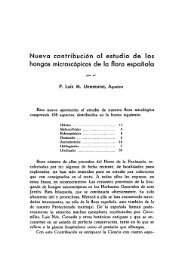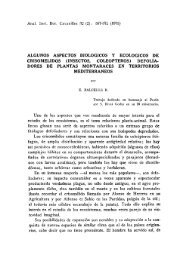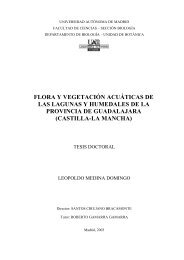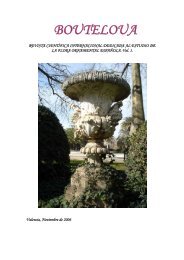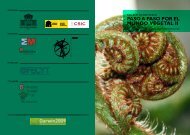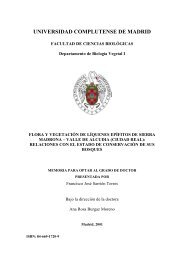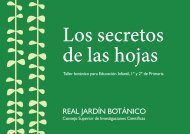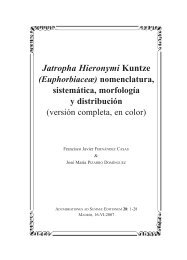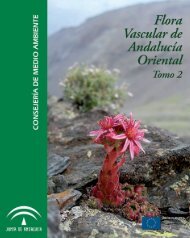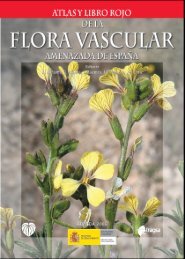Folia Botanica Extremadurensis, vol. 5 (2011) - Biblioteca digital del ...
Folia Botanica Extremadurensis, vol. 5 (2011) - Biblioteca digital del ...
Folia Botanica Extremadurensis, vol. 5 (2011) - Biblioteca digital del ...
- No tags were found...
Create successful ePaper yourself
Turn your PDF publications into a flip-book with our unique Google optimized e-Paper software.
<strong>Folia</strong> <strong>Botanica</strong> <strong>Extremadurensis</strong> Vol. 5American Black Oaks Diversity in ExtremaduraDavid GarcíaGrupo HABITAT, Departamento de Producción Forestal, Centro de Investigación Finca La Orden –Valdesequera. Vicepresidencia Segunda y Consejería de Economía, Comercio e Innovación. Junta deExtremadura. Km. 372. 06187 Guadajira (Badajoz) Spain.E-mail: david.garcia@juntaextremadura.netOaks are one of the most important woody group of the Northern Hemisphere whichhave provided an important source of many products as timber, fuel, tannins, acorns , etc(Nixon, 1997).The group of species we know commonly as red or black oaks are included in thesection Lobatae G. Don in J. C. Loudon, Hort. Brit. 385. 1830 (Genus Quercus LinnaeusGen. Pl. ed. 5, 431, 1754). The natural distribution range of these species is mainly NorthAmerica, Mexico, Central America, and Colombia, in South America. In particular, aboutthirty-five species of them are distributed in North America and Mexico (Jensen, 1997).The main characteristics which are commonly used to differentiate them from thespecies of the other major groups (sect. Protobalanus (Trelease) A. Camus, 1: 157. 1938, sect.Quercus Linnaeus) are: leaf lobes (commonly bristle-tipped), cup scales (flattened, nevertuberculate, never embedded in tomentum), nut (inner wall silky-tomentose) and acornmaduration (biennial, rarely annual) (Miller & Lamb, 1985; Jensen, 1997)These species have been used in Spain for its ornamental value and timberproduction. Actually there are cities in Spain that are using species of the genus Quercus inparks and gardens, mainly for its autumnal colorations, size, habit, etc. and also are trying toform collections of them (for example, cities as Oviedo in the north of Spain and Caceres inExtremadura) (Vázquez, com. pers.).On the other hand, the northern red oak (Quercus rubra) has been used in Spain fortimber production. It was introduced in Europe in the seventeenth century. Its distributionrange in the Iberian Peninsula mainly strecht the Basque Country, Navarra, the Cantabrianstrip, Galicia and the northern part of Portugal, with a total surface of 10.000 hectaresdistributed in small plots (Aunós, 2008).Actually, we can find two collections of black oaks in Extremadura (Southwest of theIberian Peninsula). One of them is in Madrigal de la Vera (Caceres, Spain) and the other oneis in the La Orden-Valdesequera Research Center (Badajoz, Spain).The first one is provided with 36 taxons of the genus Quercus coming from Spain,Europe and North America, of which 15 of them are hybrids. The aim of this collection is toestablish species and provenances field trials, as well as, the clonal selection of trees directedto produce high quality timber with short forest rotations.There we can find 23 taxons in the group of the american black oaks, which 12 ofthem are hybrids (Table 1).SpeciesHybridsQuercus coccinea Münchh. Hausvater v. 254 (1770); cf. Little Quercus x benderi Baen. Allg. Bot. Z. Syst. 9: 85. 1903in Journ. Wash. Acad. Sci. xxxiii. 10 (1943). in obs.(=Quercus rubra L. x coccinea Münchh.)Quercus falcata Michx.Hist. Chênes Amér. Quercus no. 16 (t. Quercus × capesii W.Wolf Castanea x. 91, 120 (1945) (=28) (1801)Quercus nigra L. x phellos L.)Quercus hemisphaerica Bartram ex Willd., Sp. Pl. 4: 443 Quercus × egglestonii Trel. Mem. Natl. Acad. Sci. 20: 14. 19 (=(1805)Quercus imbricaria Michx. x shumardii Buckl.)Quercus laurifolia Michx. Hist. Chênes Amér. t. 17 (1801) Quercus x discreta Laughlin, Phytologia 7: 411 (1961) (=Quercus shumardii Bucklery x velutina Lam.)Quercus muehlenbergii Engelm. Trans. Acad. Sci. St. Louis Quercus x fontana Laughlin, Phytologia, 15: 294 (1967) (=3(25): 391 (1877)Quercus coccinea Münchh. x velutina Lam.)Quercus nigra L. Sp. Pl. 2: 995 (1753)Quercus × mutabilis E. J. Palmer & Steyerm. Ann. MissouriBot. Gard. 22: 521. 1935 (= Quercus palustris Munchh. xshumardii Buckl.)Quercus pagoda Raf. Alsogr. Amer. 23 (Quid) (1838)Quercus x riparia Laughlin, Phytologia 9: 102. (1963) (Quercusrubra L. x shumardii Buckl.),Quercus palustris Münchh. Hausvater v. 253 (1770); cf. Little Quercus incana W. Bartram x Q. phellos L.in Journ. Wash. Acad. Sci. xxxiii. 10 (1943). in obs.Quercus phellos L. Sp. Pl. 2: 99 (1753)Quercus coccinea Münchh. x Q. shumardii Buckl.,Quercus rubra L. Sp. Pl. 2: 996 (1753) Quercus laurifolia Michx. x Q. phellos L.Quercus shumardii Buckley Proc. Acad. Nat. Sci. Phila<strong>del</strong>phia Quercus laurifolia Michx. x Q. nigra L.444 (1860-1861)Quercus velutina Lam. Encycl. (Lamarck) 1(2): 721 (1785)Table 1. Taxons included in the Bosques Naturales S.A. collection (Madrigal de la Vera, Extremadura, Spain).110



